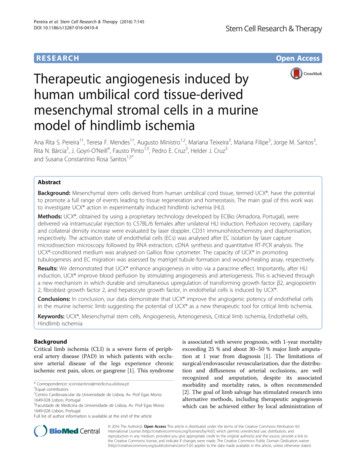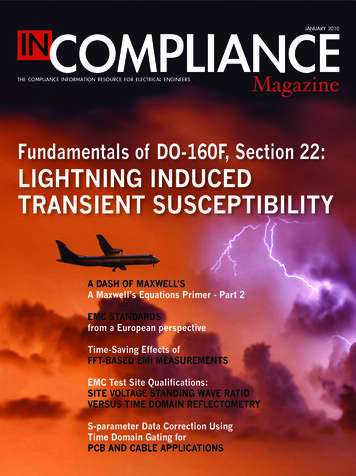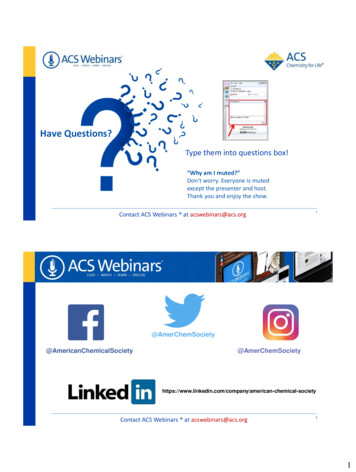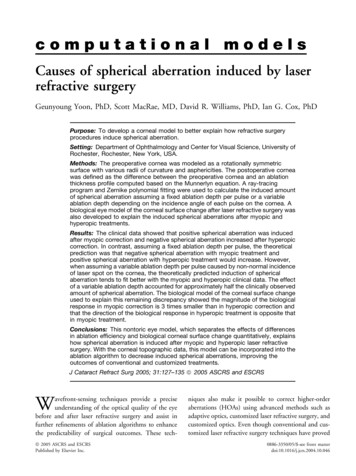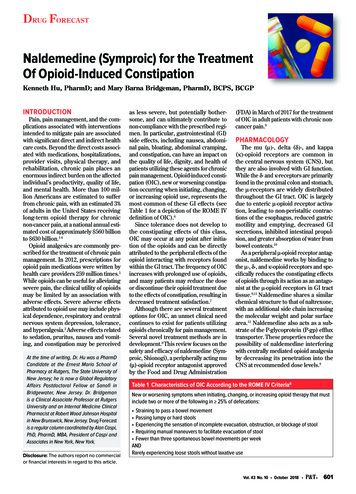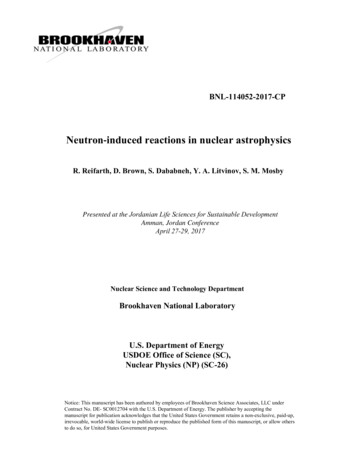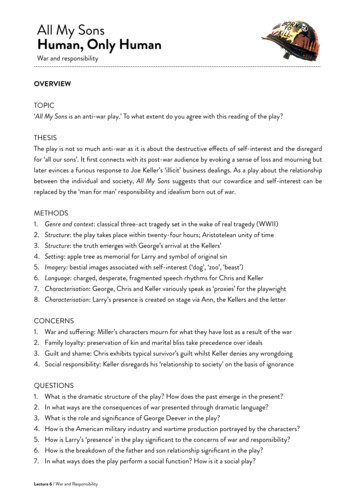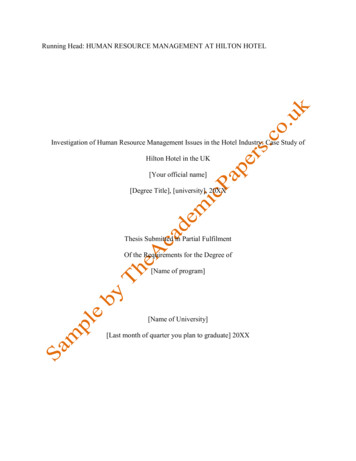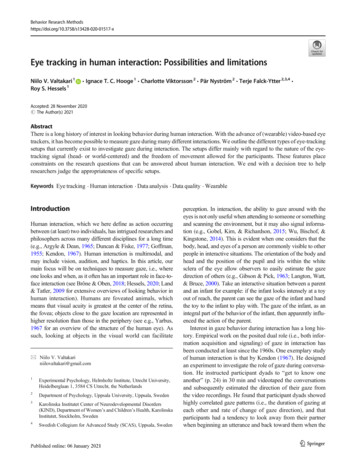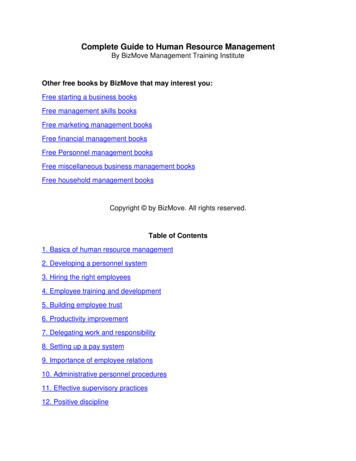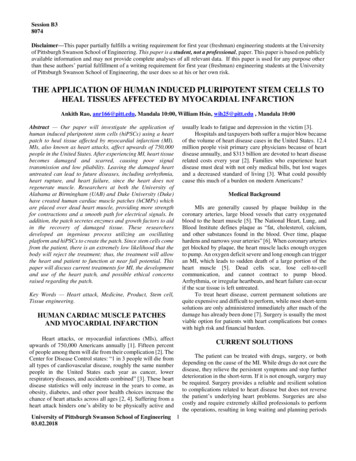
Transcription
Session B38074Disclaimer—This paper partially fulfills a writing requirement for first year (freshman) engineering students at the Universityof Pittsburgh Swanson School of Engineering. This paper is a student, not a professional, paper. This paper is based on publiclyavailable information and may not provide complete analyses of all relevant data. If this paper is used for any purpose otherthan these authors’ partial fulfillment of a writing requirement for first year (freshman) engineering students at the Universityof Pittsburgh Swanson School of Engineering, the user does so at his or her own risk.THE APPLICATION OF HUMAN INDUCED PLURIPOTENT STEM CELLS TOHEAL TISSUES AFFECTED BY MYOCARDIAL INFARCTIONAnkith Rao, anr166@pitt.edu, Mandala 10:00, William Hsin, wih25@pitt.edu , Mandala 10:00Abstract — Our paper will investigate the application ofhuman induced pluripotent stem cells (hiPSCs) using a heartpatch to heal tissue affected by myocardial infarction (MI).MIs, also known as heart attacks, affect upwards of 750,000people in the United States. After experiencing MI, heart tissuebecomes damaged and scarred, causing poor signaltransmission and low pliability. Leaving the damaged heartuntreated can lead to future diseases, including arrhythmia,heart rupture, and heart failure, since the heart does notregenerate muscle. Researchers at both the University ofAlabama at Birmingham (UAB) and Duke University (Duke)have created human cardiac muscle patches (hCMPs) whichare placed over dead heart muscle, providing more strengthfor contractions and a smooth path for electrical signals. Inaddition, the patch secretes enzymes and growth factors to aidin the recovery of damaged tissue. These researchersdeveloped an ingenious process utilizing an oscillatingplatform and hiPSCs to create the patch. Since stem cells comefrom the patient, there is an extremely low likelihood that thebody will reject the treatment; thus, the treatment will allowthe heart and patient to function at near full potential. Thispaper will discuss current treatments for MI, the developmentand use of the heart patch, and possible ethical concernsraised regarding the patch.Key Words — Heart attack, Medicine, Product, Stem cell,Tissue engineering.HUMAN CARDIAC MUSCLE PATCHESAND MYOCARDIAL INFARCTIONHeart attacks, or myocardial infarctions (MIs), affectupwards of 750,000 Americans annually [1]. Fifteen percentof people among them will die from their complication [2]. TheCenter for Disease Control states: “1 in 3 people will die fromall types of cardiovascular disease, roughly the same numberpeople in the United States each year as cancer, lowerrespiratory diseases, and accidents combined” [3]. These heartdisease statistics will only increase in the years to come, asobesity, diabetes, and other poor health choices increase thechance of heart attacks across all ages [2, 4]. Suffering from aheart attack hinders one’s ability to be physically active andUniversity of Pittsburgh Swanson School of Engineering 103.02.2018usually leads to fatigue and depression in the victim [3].Hospitals and taxpayers both suffer a major blow becauseof the volume of heart disease cases in the United States. 12.4million people visit primary care physicians because of heartdisease annually, and 313 billion are devoted to heart diseaserelated costs every year [2]. Families who experience heartdisease must deal with not only medical bills, but lost wagesand a decreased standard of living [3]. What could possiblycause this much of a burden on modern Americans?Medical BackgroundMIs are generally caused by plaque buildup in thecoronary arteries, large blood vessels that carry oxygenatedblood to the heart muscle [5]. The National Heart, Lung, andBlood Institute defines plaque as “fat, cholesterol, calcium,and other substances found in the blood. Over time, plaquehardens and narrows your arteries” [6]. When coronary arteriesget blocked by plaque, the heart muscle lacks enough oxygento pump. An oxygen deficit severe and long enough can triggeran MI, which leads to sudden death of a large portion of theheart muscle [5]. Dead cells scar, lose cell-to-cellcommunication, and cannot contract to pump blood.Arrhythmia, or irregular heartbeats, and heart failure can occurif the scar tissue is left untreated.To treat heart disease, current permanent solutions arequite expensive and difficult to perform, while most short-termsolutions are only administered immediately after much of thedamage has already been done [7]. Surgery is usually the mostviable option for patients with heart complications but comeswith high risk and financial burden.CURRENT SOLUTIONSThe patient can be treated with drugs, surgery, or bothdepending on the cause of the MI. While drugs do not cure thedisease, they relieve the persistent symptoms and stop furtherdeterioration in the short-term. If it is not enough, surgery maybe required. Surgery provides a reliable and resilient solutionto complications related to heart disease but does not reversethe patient’s underlying heart problems. Surgeries are alsocostly and require extremely skilled professionals to performthe operations, resulting in long waiting and planning periods
Ankith RaoWilliam Hsinbefore receiving critically needed care. Below, we discuss thefour most prevalent solutions: daily medication and lifestylechanges, bypass surgery, heart transplant, and minimallyinvasive heart surgery.another heart attack is highly possible if the surgery is doneimproperly. Other risks include changes in heart rhythm, lunginfection, nerve injuries, and death [11]. After the procedure iscompleted, the patient usually stays in the hospital for anotherweek to make sure both the graft is functioning properly, andtheir vital signs are normal [10]. It still takes anywhere fromsix to twelve weeks to make a significant recovery given noother complications arise. Patients usually experience little tono symptoms for ten to fifteen years after the procedure.However, the patient is kept on daily medication and a strictdiet following the procedure to mitigate and prevent futureplaque buildup [10].Daily Medication and RehabilitationDaily medication and rehabilitation fix the root problemof heart disease: plaque buildup in the main arteries of theheart. However, they do not reverse the problems that the deadheart tissue creates. This method of treatment is difficult toapply on its own because having a damaged heart prevents thepatient from exercising heavily or at all, which is key tohelping lower cholesterol and fats in the body. Therefore,medication and dieting are prescribed after the patientundergoes any type of surgery.For post-treatment, drugs such as diuretics, vasodilators,and statins are prescribed. Diuretics remove excess water andsodium in the body through urination to help lower bloodpressure [8]. Furthermore, it decreases the buildup of fluid inthe lungs and other parts of the body. Vasodilators relax bloodvessels to increase blood and oxygen flow to the heart toreduce chest pain. Statins reduce the amount of harmfulcholesterol in your body [8]. These drugs and many moreworking in conjunction can extend the patient’s life for morethan a decade.Medications are prescribed based on a patient’s risk ofblood clots and bleeding. The type of medication and durationof treatment is determined in conjunction with the patient’shealthcare provider [8]. Unfortunately, these drugs areexpensive and must be taken for at least 12 months followingthe MI. A popular brand of statin called Lipitor can cost up to200 dollars a month, depending on the dosage [9]. Patients areusually prescribed more than one drug, causing bills toaccumulate rapidly. Patients also are required to have regularcheckups with their doctors to document improvement in theirhealth or mitigate unforeseen complications.Heart TransplantThis operation is designed for patients with a failing anddiseased heart in which their failing organ is replaced with ahealthier donor heart. It is a treatment that is reserved forpeople who have tried medications or other surgeries but haveseen no significant improvement in their health [12]. Thepatient’s heart can become non-functioning in several ways.Frequently, it is because one or both ventricles are notfunctioning properly, and severe heart failure is very likely.Ventricular failure can happen in many forms of heart diseasebut is more common in defects with a single ventricle or iflong-standing valve obstruction or leakage has led toirreversible heart failure.Doctors remove the patient's heart by transecting theaorta, main pulmonary artery, the superior and inferior venacavae, and dividing the left atrium [13]. As a result, thisexposes the back wall of the left atrium with the pulmonaryvein openings in place. The surgeon connects the donor heartby sewing together the recipient and donor vena cava, aorta,pulmonary artery and left atrium.After the extensive surgery, patients are placed in theintensive care unit (ICU). Many are generally moved to aregular hospital room after a few days in the ICU and willusually remain in the hospital for a week or two [12]. Theamount of time spent in the ICU and hospital can vary. Patientsare closely monitored, after leaving the hospital, at anoutpatient transplant center by their respective transplant team.Due to the frequency and intensity of the monitoring, manypeople stay close by the transplant center for the first threemonths. Afterward, the follow-up visits are less frequent, andit is more convenient to travel back and forth for follow-upvisits. In addition to this, they are monitored for any signs orsymptoms of rejection, such as shortness of breath, fever,fatigue, infrequent urination or weight gain. Patients haveregular tests, including blood work, echocardiograms,electrocardiograms and heart biopsies [12].The main risk associated with this procedure is rejectionof the organ. If the donor heart is not compatible with thepatient’s body, the patient’s immune system will target thedonor heart and destroy it as if it were some sort of pathogen.Along with this risk comes similar risks to open heart surgery,including arrhythmia.Heart Bypass SurgeryHeart bypass surgery, also known as coronary artery graftsurgery, is carried out in cases where the patient has a diseasedartery or a blockage that cannot be removed in any number ofarteries [10]. Bypasses can be single, double, triple, orquadruple, depending on how many arteries are irreparable.The procedure constructs a detour around a blockedartery to improve blood flow to the patient’s heart. First, thepatient is put under general anesthesia, causing them to feel nopain throughout their body [11]. A surgeon then proceeds toremove an artery from another part of your body, usually thelegs, and uses it as a blood bypass around the blocked artery inyour heart.Patients have lessened or no chest pain, a lower chanceof heart attack, and more energy. Although heart bypasssurgery is common and generally successful, it carries manyrisks. Because it is an open-heart surgery, suffering from2
Ankith RaoWilliam HsinMinimally Invasive Heart SurgeryTISSUE ENGINEERING TECHNIQUESMIHS is a safer and better alternative to heart bypasssurgery. Unfortunately, not everyone can undergo theprocedure. The patient’s doctor thoroughly reviews thepatient’s medical history and performs some physical tests todetermine if this type of surgery is appropriate [14]. Potentialbenefits of MIHS include less blood loss and infection risk, ashorter hospital visit, and a reduced recovery time [14].The type of MIHS we will discuss is robot-assistedMIHS. In lieu of cutting open the patient’s chest to access theheart, surgeons make small incisions between the patient’sright ribs for device insertion [14]. The surgeon utilizes aremote console that controls robotic arms that exactlyreplicates the movements he or she makes. The Mayo Clinicstates: “The surgeon works at a remote console and views yourheart in a magnified high-definition 3D view on a videomonitor” [14]. A team of assistants replaces attachments on therobot arms as the procedure continues. Other than this, MIHSis essentially the same as heart bypass surgery, where an arteryfrom one part of the patient’s body gets grafted onto the heart.MIHS carries the same risks as other open-heartsurgeries, including chance of stroke, arrhythmia, and woundinfection. The recovery period for MIHS is significantlyshorter than that of bypass surgery, but the patient still cannotdo many normal things for a short while after the surgery, likedriving a car [14].All the methods have a long timeframe and only cureeither the underlying reason the patient’s arteries are beingclogged or the damage done to the heart because of the MI. Apatient-specific, reliable, and cost-efficient replacement to thecurrent methods is necessary to reduce constant strain onhospitals across the country that need to treat heart attackpatients.To understand how the UAB and Duke researcherscreated the hCMP, one must first understand what humaninduced pluripotent stem cells (hiPSCs) and gel scaffolds areand how they provide the basis for creating the hCMP.Human Induced Pluripotent Stem CellsGenes encode proteins which decide a cell’s function.Cells only express a small fraction of genes at any given time.Therefore, the expressed genes determine the behavior of thatcell. Every cell has a unique set of transcription regulators thatdifferentiate cells from one another [16]. These regulatorsfunction to either induce or suppress transcription. With themanipulation of these transcription factors comes the inventionof pluripotent stem cells. By introducing four specific genesencoding for transcription factors, cells can be converted intopluripotent stem cells.HEART MUSCLE PATCHES: ANEFFICIENT SOLUTIONResearchers at the University of Alabama Birmingham(UAB) and Duke University (Duke) have recently developeda tissue engineering alternative to current MI surgeries. Theycreated the human cardiac muscle patch (hCMP), which can beplaced over damaged heart tissue. The goal of their researchwas to create a patch suitable for human use (4 cm x 2 cm x1.25 mm) that solved issues that dead heart muscle created.The hCMP significantly improved cell-to-cell communicationand forcefulness of heartbeats, allowing swine heart affectedby MI to function statistically significantly better than theiruntreated MI counterparts [15]. Stem cells and their broad useshave manifested yet again in a solution for MI damage. Thispatch holds promise to have widespread use in hospitals as analternative to current operations. Below, we discuss how stemcells and tissue engineering techniques used in creating thehCMP came to be and why they work.FIGURE 1 [18]Flowchart of iPSC creationhiPSCs are derived from human skin or blood cells thathave been reprogrammed back into an embryonic-likepluripotent state that enables the development of an unlimitedsource of any type of human cell needed for therapeuticpurposes [17]. These cells hold much promise in the field ofregenerative medicine because they can multiply indefinitelyand have applications in biology, drug development, andtransplantation. hiPSCs are genetically forced to express genesand factors important for maintaining the defining propertiesof embryonic stem cells.3
Ankith RaoWilliam HsinSince iPSCs can be derived directly from adult tissues,they not only bypass the need for embryos, but can be made ina patient-matched manner, which means that everyone couldhave their own pluripotent stem cell line. An unlimited supplyof the patient’s own cells could be used to generate transplantswithout the risk of immune rejection. While iPSC technologyhas not yet advanced to a stage where therapeutic transplantshave been deemed safe, iPSCs are readily being used inpersonalized drug discovery efforts and understanding thepatient-specific basis of disease.Unlike iPSCs, hiPSCs still require much clearance beforebeing used in clinical trials. Currently viruses are used tointroduce the reprogramming factors into adult cells, and thisprocess must be carefully controlled and tested before thetechnique can lead to useful treatment for humans. In animalstudies, the virus used to introduce the stem cell factorssometimes causes cancers. Researchers are currentlyinvestigating non-viral delivery strategies. In any case, thisbreakthrough discovery has created a powerful new way to"de-differentiate" cells whose developmental fates had beenpreviously assumed to be determined. In addition, tissuesderived from iPSCs will be a nearly identical match to the celldonor and thus probably avoid rejection by the immunesystem.attempt to destroy or get rid of it. As the stem cells begin tointegrate into the heart, the fibrin scaffold also gets brokendown and recycled. These reasons are why fibrin scaffolds area very sustainable foundation to grow hCMPs on.PATCH PRODUCTIONThe goal of the UAB and Duke research was to create aclinically-relevant muscle patch to improve heart functionfollowing an MI. They achieved this by combining a few keyprinciples: cells grown in 3D environments function betterthan those grown in 2D environments, hiPSCs differentiatedinto cardiomyocytes are more efficient and less likely to diewhen grown with endothelial cells and smooth muscle cells,and a rocking culture process helps cells mature faster [15].FIGURE 2 [15]Flowchart of the hCMP culture processFibrin Gel ScaffoldingEach patch is a mixture of three cell types: 4 millioncardiomyocytes, or heart-muscle cells; 2 million endothelialcells, which are well-known to help cardiomyocytes surviveand function in a micro-environment; and 2 million smoothmuscle cells, which line blood vessels [21]. This ratio of 2:1:1provides the optimal support for the cardiomyocytes andmaximizes functionality. Figure 2 above depicts the processthat the researchers used to grow the muscle patches. The cellmixture was combined with fibrinogen and placed on a platewith thrombin to start the scaffold polymerization reaction[15]. Submerged in growth solution, the patch was placed on adynamic rocker to simulate the environment it wouldeventually be applied to.After just one day of culturing, the cells began to sendsignals to each other and contracted like a cohesive muscle. Aminimal number of cells died and the same 2:1:1 ratio wasmaintained after a week of growth [15]. The patch alsocontracted stronger when it was stretched compared to when itwas unstretched, which is how cardiac muscle is usually is.Compared to patches created on a 2D scaffold and thosecreated without endothelial or smooth muscle cells, the hCMPdisplayed better electrical signaling and muscle contractionproperties.Gel scaffolds are a sort of skeleton scientists use to growcells on. The type of scaffolds used by the UAB and Dukeresearchers was a fibrin hydrogel. Fibrinogen is a proteinfound in the body that aids in wound healing by providing anatural scaffold for other proteins and cells to bind to. Uponinteracting with the chemical thrombin, fibrinogen splits intofibrin, which rapidly creates an extracellular-matrix-likeenvironment near the wound. Fibrin holds many physicalproperties useful to research scientists. These includebiodegradability, biocompatibility, easy purification, highabundance and modifiability, and high tensile strength uponstretching [21]. Fibrin is quite soft compared to otherbiopolymers, says Janmey, Winer, and Weisel, which lendsitself well to being a mold for cells to grow into [21].Fibrin scaffolds are created in a similar fashion to howthey are created in the body. Fibrinogen, found abundantly inblood plasma, is fully dissolved in a buffered saline solution.The solution then undergoes dialysis, a liquid purificationprocess, for twelve hours. The dialyzed solution is filteredtwice more before being transferred into small dish called a 24well plate. In each well or cavity, fibrinogen is combined withthrombin and calcium chlorid
The type of MIHS we will discuss is robot-assisted MIHS. In lieu of cutting open the patient’s chest to access the heart, surgeons make small incisions between the patient’s right ribs for device insertion [14]. The surgeon utilizes a remote
